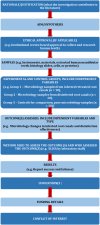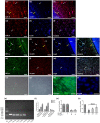MicroRNA-22 suppresses NLRP3/CASP1 inflammasome pathway-mediated proinflammatory cytokine production by targeting the HIF-1α and NLRP3 in human dental pulp fibroblasts
- PMID: 35979583
- PMCID: PMC9805103
- DOI: 10.1111/iej.13814
MicroRNA-22 suppresses NLRP3/CASP1 inflammasome pathway-mediated proinflammatory cytokine production by targeting the HIF-1α and NLRP3 in human dental pulp fibroblasts
Abstract
Aim: To investigate the synergetic regulatory effect of miR-22 on HIF-1α and NLRP3, subsequently regulating the production of the NLRP3/CASP1 inflammasome pathway-mediated proinflammatory cytokines IL-1β and IL-18 in human dental pulp fibroblasts (HDPFs) during the progression of pulpitis.
Methodology: Fluorescence in situ hybridization (FISH) and immunofluorescence (IF) were performed to determine the localization of miR-22-3p, NLRP3 and HIF-1α in human dental pulp tissues (HDPTs). The miR-22 mimics and inhibitor or plasmid of NLRP3 or HIF-1α were used to upregulate or downregulate miR-22 or NLRP3 or HIF-1α in HDPFs, respectively. Computational prediction via TargetScan 5.1 and a luciferase reporter assay were conducted to confirm target association. The mRNA and protein expression of HIF-1α, NLRP3, caspase-1, IL-1β and IL-18 were determined by qRT-PCR and western blotting, respectively. The release of IL-1β and IL-18 was analysed by ELISA. The significance of the differences between the experimental and control groups was determined by one-way analysis of variance, p < .05 indicated statistical significance.
Results: A decrease in miR-22 and an increase in HIF-1α and NLRP3 in HDPTs occurred during the transformation of reversible pulpitis into irreversible pulpitis compared with that in the healthy pulp tissues (p < .05). In the normal HDPTs, miR-22-3p was extensively expressed in dental pulp cells. HIF-1α and NLRP3 were mainly expressed in the odontoblasts and vascular endothelial cells. Whereas in the inflamed HDPTs, the odontoblast layers were disrupted. HDPFs were positive for miR-22-3p, HIF-1α and NLRP3. Computational prediction via TargetScan 5.1 and luciferase reporter assays confirmed that both NLRP3 and HIF-1α were direct targets of miR-22 in HDPFs. The miR-22 inhibitor further promoted the activation of NLRP3/CASP1 inflammasome pathway induced by ATP plus LPS and hypoxia (p < .05). In contrast, the miR-22 mimic significantly inhibited the NLRP3/CASP1 inflammasome pathway activation induced by ATP plus LPS and hypoxia (p < .05).
Conclusion: MiR-22, as a synergetic negative regulator, is involved in controlling the secretion of proinflammatory cytokines mediated by the NLRP3/CASP1 inflammasome pathway by targeting NLRP3 and HIF-1α. These results provide a novel function and mechanism of miR-22-HIF-1α-NLRP3 signalling in the control of proinflammatory cytokine secretion, thus indicating a potential therapeutic strategy for future endodontic treatment.
Keywords: HIF-1α; IL-1β; NLRP3; human dental pulp fibroblasts; miR-22; pulpitis.
© 2022 The Authors. International Endodontic Journal published by John Wiley & Sons Ltd on behalf of British Endodontic Society.
Conflict of interest statement
The authors declare that there is no conflict of interest regarding the publication of this paper.
Figures










Similar articles
-
Hypoxia-induced NLRP3 inflammasome activation via the HIF-1α/NF-κB signaling pathway in human dental pulp fibroblasts.BMC Oral Health. 2024 Sep 29;24(1):1156. doi: 10.1186/s12903-024-04936-w. BMC Oral Health. 2024. PMID: 39343901 Free PMC article.
-
MicroRNA-223 negatively regulates LPS-induced inflammatory responses by targeting NLRP3 in human dental pulp fibroblasts.Int Endod J. 2021 Feb;54(2):241-254. doi: 10.1111/iej.13413. Epub 2020 Oct 17. Int Endod J. 2021. PMID: 32966618
-
Mechanisms that lead to the regulation of NLRP3 inflammasome expression and activation in human dental pulp fibroblasts.Mol Immunol. 2015 Aug;66(2):253-62. doi: 10.1016/j.molimm.2015.03.009. Epub 2015 Apr 2. Mol Immunol. 2015. PMID: 25863775
-
The Roles and Molecular Mechanisms of HIF-1α in Pulpitis.J Dent Res. 2025 Jul;104(7):715-724. doi: 10.1177/00220345251320970. Epub 2025 Mar 18. J Dent Res. 2025. PMID: 40102725 Review.
-
MicroRNAs as important regulators of the NLRP3 inflammasome.Prog Biophys Mol Biol. 2020 Jan;150:50-61. doi: 10.1016/j.pbiomolbio.2019.05.004. Epub 2019 May 15. Prog Biophys Mol Biol. 2020. PMID: 31100298 Review.
Cited by
-
Roles of Pyroptosis in the Progression of Pulpitis and Apical Periodontitis.J Inflamm Res. 2025 Mar 7;18:3361-3375. doi: 10.2147/JIR.S507198. eCollection 2025. J Inflamm Res. 2025. PMID: 40084091 Free PMC article. Review.
-
Roles of PANoptosis and related genes in acute liver failure: neoteric insight from bioinformatics analysis and animal experiment verification.J Zhejiang Univ Sci B. 2025 Apr 23;26(4):353-370. doi: 10.1631/jzus.B2300678. J Zhejiang Univ Sci B. 2025. PMID: 40274384 Free PMC article.
-
Clustering human dental pulp fibroblasts spontaneously activate NLRP3 and AIM2 inflammasomes and induce IL-1β secretion.Regen Ther. 2024 Mar 7;27:12-20. doi: 10.1016/j.reth.2024.02.010. eCollection 2024 Dec. Regen Ther. 2024. PMID: 38487102 Free PMC article.
-
Significance of pyroptosis-related genes in the diagnosis and classification of diabetic kidney disease.Ren Fail. 2024 Dec;46(2):2409331. doi: 10.1080/0886022X.2024.2409331. Epub 2024 Oct 8. Ren Fail. 2024. PMID: 39378104 Free PMC article.
-
Hypoxia-induced NLRP3 inflammasome activation via the HIF-1α/NF-κB signaling pathway in human dental pulp fibroblasts.BMC Oral Health. 2024 Sep 29;24(1):1156. doi: 10.1186/s12903-024-04936-w. BMC Oral Health. 2024. PMID: 39343901 Free PMC article.
References
-
- Chang, M.C. , Lin, L.D. , Zwei‐Ching Chang, J. , Huang, C.F. , Chuang, F.H. , Lee, J.J. et al. (2012) Regulation of vascular cell adhesion molecule‐1 in dental pulp cells by interleukin‐1beta: the role of prostanoids. Journal of Endodontis, 38, 774–779. - PubMed
-
- Chang, M.C. , Tsai, Y.L. , Chang, H.H. , Lee, S.Y. , Lee, M.S. , Chang, C.W. et al. (2016) IL‐1beta‐induced MCP‐1 expression and secretion of human dental pulp cells is related to TAK1, MEK/ERK, and PI3K/Akt signaling pathways. Archives of Oral Biology, 61, 16–22. - PubMed
MeSH terms
Substances
Grants and funding
- 2019KJXX-086/Innovative Talents Promotion Program-Youth Science and Technology Star Project
- 015216/Ling Yun Project-Eagle Programme from the Fourth Military Medical University
- 81700951/National Natural Science Foundation of China
- 81771095/National Natural Science Foundation of China
- 81803186/National Natural Science Foundation of China
LinkOut - more resources
Full Text Sources
Miscellaneous

